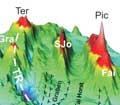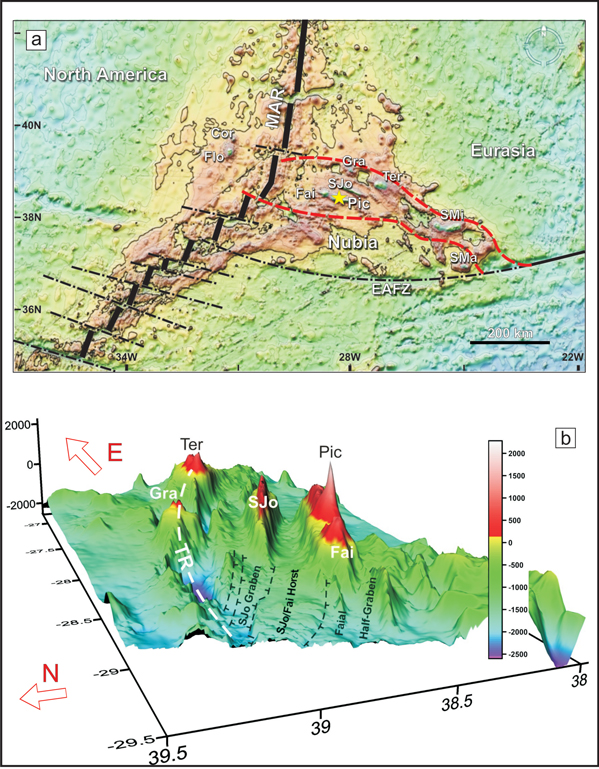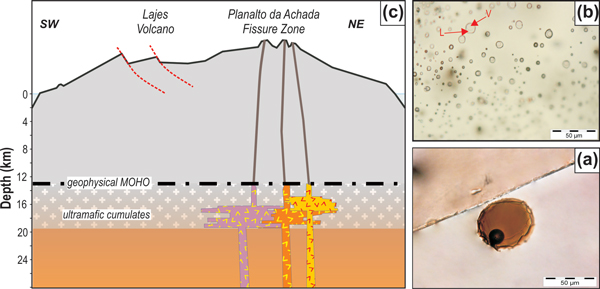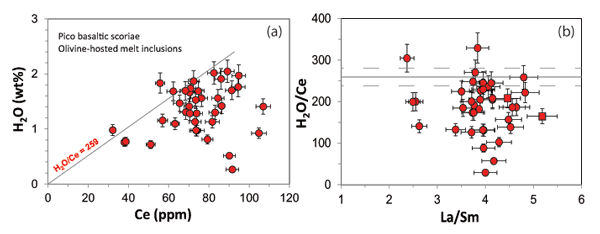 |
Water beneath the Azores: Mantle melting in a transtensional geodynamic setting |
Nicole Métrich1, Vittorio Zanon2, Laura Créon1,3, Anthony Hildenbrand3,4, Manuel Moreira1, Fernando Ornelas Marques5
1Institut de Physique du Globe, Sorbonne Paris-Cité, Université Paris Diderot, UMR-CNRS 7154, Paris, F-75005, France; metrich@ipgp.fr ; laura.creon-bocquet@ifpen.fr ; moreira@ipgp.fr
2Centro de Vulcanologia e Avaliação de Riscos Geológicos, Universidade dos Açores, Ponta Delgada, Portugal; Vittorio.VZ.Zanon@azores.gov.pt
3Univ Paris-Sud, Laboratoire IDES, UMR 8148, Orsay, F-91405, France; anthony.hildenbrand@u-psud.fr
4CNRS, Orsay, F-91405, France
5Universidade de Lisboa, Lisboa, Portugal ; fomarques@fc.ul.pt
This webpage is a summary of: Métrich N., Zanon V., Créon L., Hildenbrand A., Moreira M., & Marques F.O. 2014. Is the “Azores hotspot” a wetspot? Insights from the geochemistry of fluid and melt inclusions in olivine of Pico basalts. Journal of Petrology 55/2, 377-393, doi: 10.1093/petrology/egt071.
The geodynamic context of the Azores and Pico Island
The Azores archipelago lies at the junction of three lithospheric plates and is transected by the mid-Atlantic Ridge (Figure 1). The central and eastern parts accommodate differential motion between the North American and Eurasian plates, and the North American and Nubian plates, along a series of WNW-ESE-trending sub-parallel rift systems. The main system is the “Terceira Rift”. The master faults of these rifts propagate through the lithosphere, allowing the ascent of mafic magmas. The southernmost system hosts the volcanic systems of Faial and Pico which form a ~ 160-km-long volcanic ridge. Our work focused on monogenetic scoria cones emplaced along the Pico axial fissure system–the Planalto da Achada Fissure Zone.

Figure 1: Tectonic framework of the Azores area. (a) Bathymetric map (from SRTM30), with main tectonic structures and plate names superimposed. The diffuse boundary, according to Marques et al. (2013, 2014), between the Nubia and Eurasia plates, inferred from GPS, bathymetric, structural and seismic data, are represented by red dashed lines. MAR refers to the Mid-Atlantic Ridge and EAFZ to the East Azores Fracture Zone. The yellow star indicates Pico Island. (b) 3D surface of the islands of the Azores Central Group. The white dashed line marks the Terceira Rift (TR) which comprises the islands of São Miguel (SMi), Terceira (Ter) and Graciosa (Gra. Black dashed lines indicate the horst-graben structures redrawn from Marques et al. (2013, 2014). SJo, Pic and Fai: São Jorge, Pico and Faial islands.
Basalt geochemistry – Direct probing of water and trace elements
Water enrichment in submarine basalts of the Azores platform was first recognized by Schilling et al. (1980) and Michael (1995). The presence of H2O and/or a positive temperature anomaly in the mantle are the main parameters responsible for polybaric hydrous melting. Melt production in the Azores was first investigated by Bonatti (1990) and Asimow et al. (2004), who invoked a process of decompression melting.
Tephra series erupted along the Pico fissure system show the typical alkali affinity of Azores basalts (e.g., Beier et al., 2012). Helium isotopic ratios measured in olivine crystals from these samples plot in a very restricted range (from Ra 10.2 - 11.1 ± 0.1). They are higher than those reported for MORB, belong to the He isotopic domain of Pico, and more broadly to that of the Azores (Moreira, 2013).
The major, trace and volatile (CO2, H2O, S, Cl) element contents of magma at depth were measured by analysing melt droplets trapped at high pressure in olivine crystals (melt inclusions; Figure 2a). In order to assess the pressures of magma ponding, we combined the fluid pressures deduced from the dissolved amounts of CO2 (up to 0.4 wt%) and H2O (up to 1.8-2.0 wt%) in melt inclusions with the density measurements of the coexisting CO2-rich fluid inclusions (Figure 2b). The calculated pressures (475-526 MPa) fall in the range previously reported for basalts (465-508 MPa) and ultramafic xenoliths (570-586 MPa) from Pico and Faial Islands (Zanon & Frezzotti, 2013). These values indicate that magma batches, emplaced along the Pico fissure system as monogenetic cones, ponded and rose from the upper lithospheric mantle at depths of ~17-19 km (Figure 2c).

Figure 2: (a) A single melt inclusion hosted in an olivine phenocryst consisting of glass and a shrinkage bubble in which CO2 can migrate upon magma ascent and decompression. (b) CO2-rich inclusions showing vapor (V) and liquid (L) phases. Both CO2-rich fluid inclusions and melt inclusions provide minimum values of fluid pressures. (c) Schematic section across Pico fissure zone, in the sampling area, with the magma storage areas.
The H2O/Ce ratio of Pico basalts was measured in melt inclusions and derived from the correlation between H2O and Ce (Figure 3a). It varies between 226 and 309, and averages 259 ± 21 (Figure 3b). A similar correlation is observed with La, as Ce/La is fairly constant (2.18 ± 0.02). This value of the H2O/Ce ratio closely matches that reported for non-degassed submarine basalts from the Azores platform (e.g., Dixon et al., 2002). The Tb/Yb and La/Yb ratios measured in both melt inclusions and Pico lava samples indicate 4 - 5% partial melting of a garnet-bearing mantle source rich in water (H2O from 570 to 680 ppm).

Figure 3: H2O-Ce, H2O/Ce and La/Sm ratios determined in olivine-hosted melt inclusions of basaltic scoria samples from Pico Island (modified from Métrich et al., 2014).
Mantle decompression melting
Quantification of the thermal anomaly associated with mantle water enrichment is critical. We estimated, potential temperatures (Tp) of 1466-1477°C for the mantle beneath Pico Island, using the PRIMELT2.XLS software (Herzberg & Asimow, 2008). These are ~30-90°C lower than the range 1494-1569°C previously published for this island (Beier et al., 2012) but in good agreement with the value of 1443±24°C reported for the Azores by Courtier et al. (2007). Relative to MORB mantle Tp of 1350°C (Herzerg & Asimow, 2008), the maximal inferred ΔT for the Azores mantle is ~ 120°C, but it could be much less.
We propose that decompression melting of a geochemically heterogeneous source, rich in water, occurs at the unusual geodynamic setting of the Azores. This idea is supported by the position of the Pico-Faial ridge, which overlies the master fault bounding the Faial Half-Graben in the north, and by the concept of a diffuse Nubia-Eurasia plate boundary (Marques et al., 2013, 2014).
References
-
Asimow, P.D., Dixon, J.E. & Langmuir, C.H. (2004). A hydrous melting and fractionation model for mid-ocean ridge basalts: application to the Mid-Atlantic Ridge near the Azores. Geochemistry, Geophysics, Geosystems 5, doi:10.1029/2003GC000568.
-
Beier, C., Haase, K.M. & Turner, S.P. (2012). Conditions of melting beneath the Azores. Lithos 144-145, 1-11.
-
Bonatti, E. (1990). Not so hot "hot spots" in the oceanic mantle. Science 250, 107-111. Geochemistry, Geophysics, Geosystems 11, Q02004.
-
Courtier, A. M., Jackson, M. G., Lawrence, J. F., Wang, Z., Lee, C. T. A., Halama, R., & Chen, W. P. (2007). Correlation of seismic and petrologic thermometers suggests deep thermal anomalies beneath hotspots. Earth and Planetary Science Letters 264, 308-316.
-
Dixon, J.E., Leist, L., Langmuir, C. & Schilling, J.G., (2002). Recycled dehydrated lithosphere observed in plumes influence mid-ocean ridge basalt. Nature 420, 28, 385-389.
-
Herzberg, C. & Asimow, P.D. (2008). Petrology of some oceanic island basalts: PRIMELT2.XLS software for primary magma calculation. Geochemistry, Geophysics, Geosystems 9, doi: 10.1029/2008GC002057.
-
Marques, F.O., Catalão, J.C., DeMets, C., Costa, A.C.G., Hildenbrand, A. (2013). GPS and tectonic evidence for a diffuse plate boundary at the Azores Triple Junction. Earth and Planetary Science Letters 381, 177-187.
-
Marques, F.O., Catalão, J.C., DeMets, C., Costa, A.C.G., and Hildenbrand, A., 2014. Corrigendum to “GPS and tectonic evidence for a diffuse plate boundary at the Azores Triple Junction” [Earth Planet. Sci. Lett. 381 (2013) 177–187]. Earth and Planetary Science Letters 387, 1-3.
-
Michael, P.J. (1995). Regionally distinctive sources of depleted MORB: Evidence from trace elements and H2O. Earth and Planetary Science Letters 131, 301-320.
-
Moreira, M. (2013). Noble gas constraints on the origin and evolution of Earth's volatiles. Geochemical Perspectives 2, pp 1-399.
-
Schilling, J.G., Bergeron, M.B. & Evans, R. (1980). Halogens in the mantle beneath the North Atlantic. Phil. Trans. R. Soc. London A297, 147-178.
-
Zanon V. & Frezzotti M.-L. (2013). Magma storage and ascent conditions beneath Pico and Faial islands (Azores Islands). A study of fluid inclusions. Geochemistry, Geophysics, Geosystems. doi: 10.1002/ggge.20221.
last updated 19th
February, 2014 |
